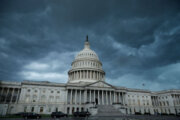Against the backdrop of the coronavirus-induced panic buying, empty shelves in grocery stores suggest to shoppers, there’s a shortage of food.
In other words, they think the food supply is not secure.
But, ask Tom Vilsack, president and CEO of the U.S. Dairy Export Council, if there’s a food shortage in the U.S., and he’ll tell you, “No.”
He said in an interview it’s a “disruption to the supply chain.”
In fact, it’s so significant that “dairy farmers, for example, can’t sell their milk,” he said.
Vilsack, who served as Secretary of Agriculture from 2009 to 2017, told WTOP, there are two reasons.
“There’s no place for them to sell their milk because kids aren’t consuming it at school. Grocery stores, because of the panic (buying), began to limit the amount of milk that was being sold.”
Here’s what most Americans don’t know.
“The farmers have been dumping millions and millions of pounds of milk because they have no market for it and that’s the sad reality,” Vilsack said.
But a new, more troubling reality is unfolding.
“The other cascading event that’s taking place now because of the virus,” Vilsack said, “Is that it’s now crept into the processing facilities and a number beginning to shut down.”
That, he said, “could potentially create a food shortage, if we had a number of processing facilities across the country shut down simultaneously.”
- Sign up for news alerts from WTOP
- From thriving to surviving: DC-area food businesses feel impact of COVID-19
- Demand for Md. crab cakes skyrockets nationwide during coronavirus pandemic
- DC, Md. and Va. schools offer learning plans, free meals for students during coronavirus closures
- Where to get tested for COVID-19 in the DC region
- Coronavirus test results in D.C., Maryland and Virginia
The Department of Agriculture is aware of the strain COVID-19 is putting on the country’s food supply system.
“Amid this crisis, there have been widespread worries that the disease could threaten the nation’s food production and supply systems and stoke inflation,” Robert Johansson, the USDA’s chief economist wrote Thursday on the USDA blog.
Many Americans, Johansson acknowledged, are beginning “to wonder whether the food they need will continue to be available and affordable as we work our way out of the outbreak.”
Johansson wrote, “The U.S agricultural market will remain well supplied and food will continue to be affordable.”
The U.S. food sector is supplied by three sources — domestic production, imports and what we have in storage. The nation also relies on a network of manufacturers and distributors to process agricultural outputs, prepare them for human consumption and move products from farms to production facilities, and finally to consumers.
“Currently, the outlook for domestic production of agricultural commodities, including cereals, meat and dairy is very good,” Johansson wrote.
He suggests that even with the disruption to the supply chain there is enough food for everyone.
“We have sufficient quantities to not only feed our country but maintain robust exports even in the face of the COVID-19 pandemic.”
But after the outbreak is over, Vilsack said he believes some changes need to be made to prevent a repeat of the current situation.
Most importantly, he said he believes those workers should treated just as first responders are.
“You’ve got to protect the frontline workers, the people that are retailing the food, people who are producing the food so that that so that the supply of food continues to get grown processed and sold.”








